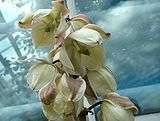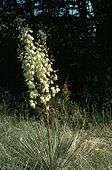Yucca glauca
Yucca glauca (syn. Yucca angustifolia) is a species of perennial evergreen plant, adapted to xeric (dry)growth conditions. It is also known as small soapweed,[2] soapweed yucca, Spanish bayonet,[3] and Great Plains yucca.
| Great Plains yucca | |
|---|---|
| Scientific classification | |
| Kingdom: | Plantae |
| Clade: | Tracheophytes |
| Clade: | Angiosperms |
| Clade: | Monocots |
| Order: | Asparagales |
| Family: | Asparagaceae |
| Subfamily: | Agavoideae |
| Genus: | Yucca |
| Species: | Y. glauca |
| Binomial name | |
| Yucca glauca | |
| Synonyms[1] | |
| |
Yucca glauca forms colonies of rosettes. Leaves are long and narrow, up to 60 cm long but rarely more than 12 mm across. Inflorescence is up to 100 cm tall, sometimes branched sometimes not. Flowers are pendent (drooping, hanging downward), white to very pale green. Fruit is a dry capsule with shiny black seeds.[4][5]
Distribution
Yucca glauca is native to central North America: occurring from the Canadian Prairies of Alberta and Saskatchewan in Canada; south through the Great Plains to Texas and New Mexico in the United States.[6][7]
Pollinators
The "honey ant" (Myrmecocystus mexicanus), among other species, has been observed collecting nectar from Y. glauca.[8]
Uses
Soapweed yucca was a traditional Native American medical plant, used by the Blackfoot, Cheyenne, Lakota, and other tribes.[2]
Among the Zuni people, the seed pods are boiled and used for food.[9] Leaves are made into brushes and used for decorating pottery, ceremonial masks, altars and other objects.[10] Leaves are also soaked in water to soften them and made into rope by knotting them together.[11] Dried leaves are split, plaited and made into water-carrying head pads.[12] Leaves are also used for making mats, cincture pads and other articles.[11] The peeled roots are pounded, made into suds and used for washing the head, wool garments and blankets.[13]
Gallery
 Yucca glauca flowers
Yucca glauca flowers Inflorescence
Inflorescence
References
- "The Plant List: A Working List of All Plant Species".
- "Native American Ethnobotany". University of Michigan–Dearborn. Retrieved 2012-09-17.
- Schiemann, Donald Anthony. Wildflowers of Montana. page 140. Mountain Press Publishing Company. Missoula. 2005.
- Flora of North America v 26 p 437, Yucca glauca
- Nuttall, Thomas. 1813. Catalogue of New and Interesting Plants Collected in Upper Louisiana no. 89.
- "Yucca glauca Nutt". Plants Profile. United States Department of Agriculture. Retrieved 2012-09-17.
- "Yucca glauca Nutt". Native Plant Database - Lady Bird Johnson Wildflower Center. University of Texas at Austin. Retrieved 2012-09-17.
- Conway, John R. "The Biology of Honey Ants."The American Biology Teacher. , Vol. 48, No. 6 (Sep., 1986), pp. 335–343.
- Stevenson, Matilda Coxe 1915 Ethnobotany of the Zuni Indians. SI-BAE Annual Report #30 p.73
- Stevenson, p.82
- Stevenson, p.79
- Bell, Willis H and Edward F. Castetter 1941 Ethnobiological Studies in the Southwest VII. The Utilization of Yucca, Sotol and Beargrass by the Aborigines in the American Southwest. University of New Mexico Bulletin 5(5):1-74 (p. 47)
- Stevenson, p.83
External links
| Wikimedia Commons has media related to Yucca glauca. |